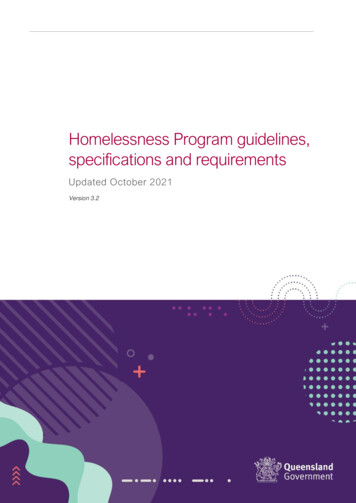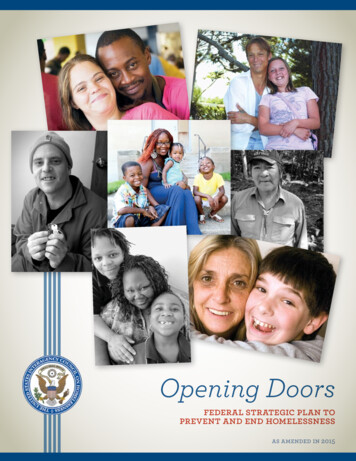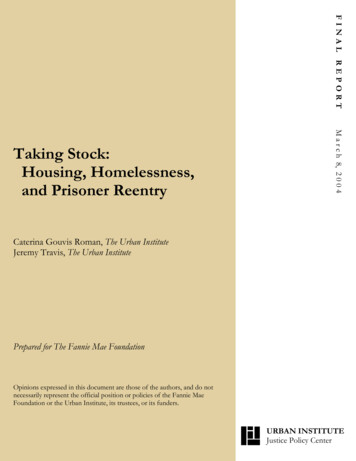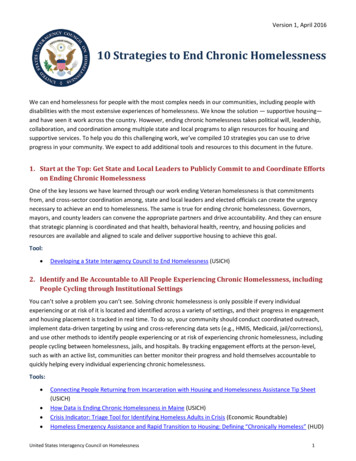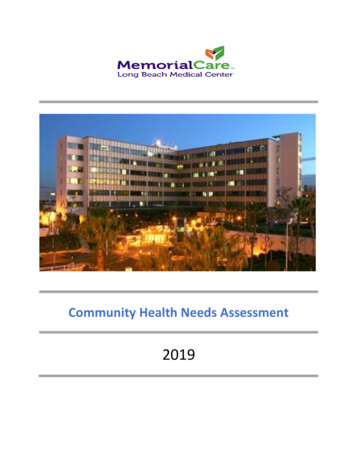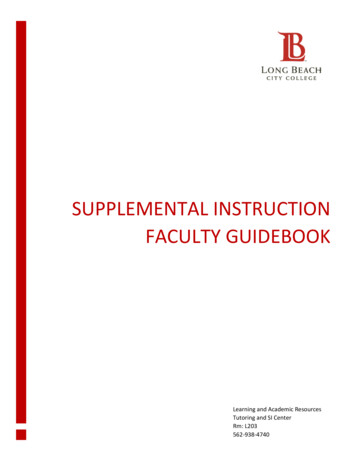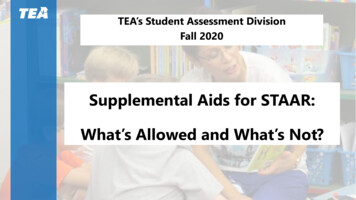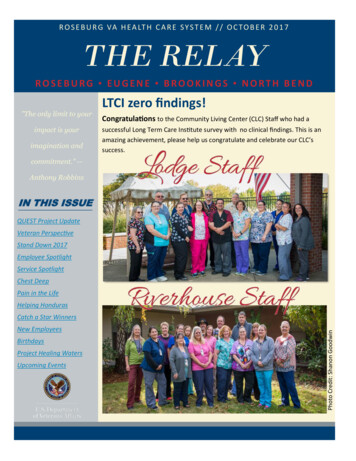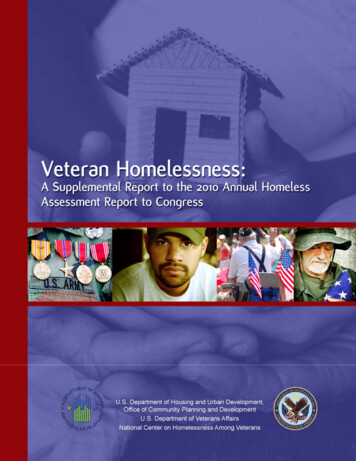
Transcription
AcknowledgementsThis Veteran Homelessness: A Supplemental Report to the 2010 Annual Homeless Assessment Report toCongress was developed by a team of researchers from Abt Associates Inc. and the U.S. Department ofVeterans Affairs National Center on Homelessness Among Veterans, affiliated with the University ofPennsylvania. The team was led by Principal Investigators, Dr. Jill Khadduri (Abt) and Dr. DennisCulhane (University of Pennsylvania). Dr. Alvaro Cortes and Ms. Meghan Henry served as co-ProjectDirectors. Additional team members include: Tom Albanese, Christopher Blaine, Scott Brown, LarryBuron, Elizabeth Copson, RJ de la Cruz, Tracy D’Alanno, Lauren Dunton, Justin Epner, Nichole Fiore,Lindsay Fox, Mary Joel Holin, Emily Holt, Ruby Jennings, Bulbul Kaul, Josh Leopold, NatalieMatthews, Ashley Muller, Tom McCall, Melissa O’Connor, Saty Patrabansh, Maura Pillsbury, MissyRobinson, Jeff Smith, Jill Spangler, K.P. Srinath, Jeff Ward, Michelle Woodford, and Matt White.Additional team members from the National Center on Homelessness Among Veterans are: ThomasByrne, Harlan Jones, Ann Elizabeth Montgomery, and Ellen Munley.This report also benefited greatly from the contributions and support of a number of HUD and VA staff.From HUD, the project was guided by Julie Hovden, Mark Johnston, Ann Oliva, and Michael Roanhousefrom the Office of Community Planning and Development. From the VA, Vince Kane and John Kuhnprovided comments to the report.Finally, this project and this report could not have been possible without the participation of staff fromContinuums of Care, local government agencies and nonprofit agencies responsible for HMISimplementation in communities across the country as well as HMIS software solution providers. Theircontinued commitment is greatly appreciated.
Table of ContentsExecutive Summary .i1.Introduction. 11.12.3.4.5.6.In this Report. 1Estimates of Homelessness among Veterans . 32.1Types of Homeless Estimates . 32.2Estimates of Homeless Veterans. 32.3How Common is Homelessness among Veterans. 4Demographic Characteristics of Sheltered Veterans. 73.1Profile of All Sheltered Veterans . 73.2Sheltered Veterans by Household Type . 93.3Sheltered Veterans Compared to Sheltered Non-Veterans . 9Risk of Homelessness among Veterans . 134.1Gender as a Risk Factor . 134.2Race and Ethnicity as Risk Factors. 144.3Age as a Risk Factor . 154.4Disability as a Risk Factor . 16Location of Homeless Veterans. 175.1PIT Estimates of Veteran Homelessness by State and Region . 175.2Location of Homeless Veterans – Principal Cities and Suburban or Rural Areas . 19How Veterans Access and Use the Shelter System. 216.1Prior Living Situation of Veterans Accessing the Shelter System. 216.2Patterns of Shelter Use. 236.3Length of Stay. 247.Permanent Supportive Housing Use by Veterans. 278.Trends in Veteran Homelessness, 2009 to 2010. 319.8.1Changes in the Estimates and Characteristics of Sheltered Homeless Veterans, 2009 to2010. 318.2Changes in the Geographic Location and Service-Use Patterns of Sheltered Veterans. 33Concluding Observations . 35Appendix A: Methodology . 37Appendix B: HMIS-Based Estimates of Veteran Homelessness, 2010. 41Appendix C: Data Tables for Calculating Risk Ratios, 2010. 53Appendix D: Point-in-Time Estimates of Homelessness and Total Populations, by State, 2010 . 55Table of Contents
Executive SummaryThe Department of Housing and Urban Development (HUD) and the Department of Veterans Affairs(VA) are pleased to present Veteran Homelessness: A Supplemental Report to the 2010 Annual HomelessAssessment Report to Congress. This second annual supplemental report is intended to providepolicymakers, practitioners, and the general public with information about the extent and nature ofveteran homelessness. The information provided in this report advances the federal effort to endhomelessness among veterans in 5 years—as described in the 2010 Federal Strategic Plan to EndHomelessness and the VA’s plan to end veteran homelessness—through the collection of timely data onveteran homelessness.Representing the ongoing and coordinated commitment between HUD and the VA to end and preventhomelessness among those who have served in our nation’s military, this Veteran Supplemental Reportprovides both 1-day and 1-year estimates of the number of homeless veterans in the United States. Inaddition to the snapshot and annual estimates, this report describes the demographic characteristics ofhomeless veterans, including race, ethnicity, gender, age, and disability status. These characteristics arecompared to those of other populations including the non-veteran homeless population, the total veteranpopulation, and the population of veterans living in poverty. These comparisons highlight the higher risksof homelessness faced by veterans, particularly poor veterans. Also discussed in this report are thelocations of homeless veterans across the country as well as how they access and use the homelessresidential system. Finally, annual comparisons of estimates are made to suggest how homelessnessamong veterans is changing over time.A summary of major findings is provided below.Estimates of Veteran Homelessness On a single night in January 2010, 76,329 veterans were living in emergency shelter, intransitional housing, or in an unsheltered place (e.g., on the streets, in cars, or in abandonedbuildings). Approximately 57 percent of those homeless on a single night were sheltered—inemergency shelter or transitional housing—and 43 percent were unsheltered.During a 12-month period (October 2009 through September 2010), an estimated 144,842veterans spent at least 1 night in emergency shelter or transitional housing programs, accountingfor 11.5 percent of all homeless adults.In 2010, homeless veterans accounted for 1 in 150 veterans and about 1 in 9 veterans living inpoverty.Most homeless veterans over the course of the year were individuals, living alone without adependent child (98 percent).Characteristics of Sheltered Homeless Veterans Homeless veterans are largely white men, between the ages of 31 and 61, with a disability.Sheltered veterans who are homeless as a part of a family are typically younger than theirindividual counterparts, minority women, and not as likely to have a disability.Homeless veterans are younger than the total veteran population, but older than the non-veteranhomeless population.Executive Summaryi
Trends in Veteran Homelessness, 2009 to 2010 The Point-in-Time count increased by 1 percent, from 75,609 homeless veterans on a single nightin 2009 to 76,329 homeless veterans on a single night in 2010.The 1-year count of sheltered veterans decreased by 3 percent between 2009 and 2010, from149,635 to 144,842.There were few changes in the characteristics of homeless veterans. Homeless veterans in 2010were slightly older, slightly more likely to be white, and slightly more likely to be disabled thanthey were in 2009.Risk of Sheltered Homelessness among Veterans Female veterans are at especially high risk of homelessness, and the risk increases considerably ifthe female veteran is poor. Female veterans are more than twice as likely to be homeless asfemale non-veterans, and female veterans in poverty are more than three times as likely to behomeless as female non-veterans in poverty.Male veterans are at a lower risk of homelessness when compared to their non-veterancounterparts; however, male veterans living in poverty are at greater risk.The prevalence of sheltered homelessness among minority groups in poverty is very high. Morethan 18 percent of poor Hispanic/Latino veterans, 26 percent of poor African American veterans,and 26 percent of poor American Indian and Alaska Native veterans were homeless at some pointduring 2010.Young veterans (between 18 and 30) are also at high risk of using the shelter system, especiallyyoung veterans in poverty. Young veterans are more than twice as likely to be homeless as theirnon-veteran counterparts, and young veterans in poverty are almost four times as likely to behomeless than their non-veteran counterparts in poverty.Location of Homeless Veterans In January 2010 four states—California, Florida, New York, and Texas—accounted for 50percent of all homeless veterans across the country. These four states accounted for 46 percent ofthe total homeless population, 32 percent of the U.S. population, and 28 percent of the totalveteran population.More than 68 percent of sheltered veterans in 2010 lived in the densest urban areas (or principalcities). This is slightly more than the share of sheltered non-veteran adults. By contrast, only 31percent of the total veteran population lived in principal cities in 2010.Prior Living Situation and Shelter Use Patterns iiMany veterans were already homeless when they entered shelter during the 1-year reportingperiod (October 2009 through September 2010). Nearly half (48 percent) of shelteredunaccompanied veterans were already homeless prior to entering the shelter system compared toalmost 32 percent of unaccompanied non-veterans in shelter.Veterans were less likely than non-veterans to access the shelter system from housing—eitherunits that they owned or rented or living with relatives or friends. Nearly 28 percent of individualveterans lived in housing prior to entering shelter compared with 37 percent of non-veteranindividuals. A small percentage, 3 percent (or 2,200 veterans) were homeowners the night priorto homelessness.Veterans are more likely to enter the shelter system directly from an institutional setting than thenon-veteran homeless population. Approximately 15 percent of veterans spent the night prior toExecutive Summary
entering shelter in jail or prison, medical or psychiatric facility, or a substance abuse treatmentcenter. Only 9 percent of sheltered non-veterans came from these institutional settings.Moreover, almost 30 percent of sheltered veterans (not already homeless) were discharged fromsubstance abuse treatment centers, jails or prisons, hospitals, or psychiatric facilities directly intohomelessness. By and large these veterans are individuals, as veterans in families do not oftenaccess shelter from institutional settings.Most veterans (75 percent) used only emergency shelter during the 12-month study period. Theremaining veterans used transitional housing alone (20 percent) or a combination of both(5 percent).Veterans in Permanent Supportive Housing Veterans in Permanent Supportive Housing (PSH) were largely male, white, between the ages of51 and 61, and disabled. Veterans living in PSH were more likely to enter the program directlyfrom homelessness (76 percent compared to 48 percent for sheltered veterans).The most common destination for veterans who exit PSH is a rented housing unit (33 percent),followed by living with a relative or friend (14 percent) or an institutional setting (14 percent).Executive Summaryiii
1.IntroductionThis second Veteran Homelessness: A Supplemental Report to the 2010 Annual Homeless AssessmentReport to Congress (2010 AHAR Veteran report) presents the scope and nature of homelessness amongveterans in the United States. The 2010 AHAR Veteran report is a companion to the AHAR report anduses both Point-in-Time data and annual longitudinal administrative data from Homeless ManagementInformation Systems (HMIS) that are reported by local Continuums of Care1 (CoC) nationwide. Includedin this report are the national estimates of homeless veterans and their demographic characteristics,locations, and patterns of shelter use. Also discussed is whether veterans are at greater risk ofhomelessness than the non-veteran population. Finally, and for the first time, this report provides anexamination of year-to-year changes in the homeless veteran population.Also new to this report is an examination of veterans living in Permanent Supportive Housing (PSH)programs. PSH programs provide housing and supportive services to tenants who typically havedisabilities. These programs help people achieve greater levels of housing stability and self-sufficiencyand have been instrumental in reducing chronic homelessness. This report provides the first estimate ofthe number of veterans using PSH programs across the country, their demographic characteristics, andtheir service use patterns.This report represents the continued partnership between the U.S. Department of Housing and UrbanDevelopment (HUD) and the Department of Veterans Affairs (VA), highlighted by both the VA Plan toend veteran homelessness and the 2010 Federal Strategic Plan to Prevent and End Homelessness. In thepast few years, both HUD and the VA have emphasized the importance of preventing homelessnessamong veterans, recognizing that prevention is a crucial part of the nation’s overall strategy to endhomelessness. The federal government’s ability to prevent and end homelessness among veterans issupported through the collection, analysis, and reporting of quality, timely data on homelessness.1.1In this ReportThe remainder of the 2010 AHAR Veteran report proceeds as follows:Section 2—Estimates of Homelessness among Veterans. This section presents the national estimates ofhomeless veterans in 2010, focusing on the prevalence of homeless veterans on a single night inJanuary 2010 and during a 12-month period (October 2009 to September 2010).Section 3—Demographic Characteristics of Sheltered Veterans. This section describes the demographiccharacteristics of sheltered homeless veterans who used emergency shelter or transitional housingprograms at some point during the 12-month reporting period.Section 4—Risk of Homelessness among Veterans. This section focuses on the proportions of differentdemographic subgroups that become homeless, comparing veterans and non-veterans. Thesecomparisons highlight the characteristics of veterans who are at greater risk of homelessness.Section 5—Location of Homeless Veterans. This section describes the geographic location of shelteredveterans across the United States and in different types of communities—rural, urban, and suburban.1Continuums of Care are local planning bodies responsible for coordinating the full range of homelessnessservices in a geographic area, which may cover a city, county, metropolitan area, or an entire state.Introduction1
Section 6—How Veterans Access and Use the Shelter System. This section describes how veterans moveinto the system and how homeless veterans use emergency shelter and transitional housing programs oncethey access services.Section 7—Permanent Supportive Housing Use by Veterans. This section presents information on thepopulation of veterans living in PSH programs. Included in this section are demographic characteristics,locations, and prior living situations of PSH tenants.Section 8—Trends in Veteran Homelessness, 2009 to 2010. This section describes the changes in thehomeless veteran estimates, characteristics, and shelter system use between 2009 and 2010.Section 9—Concluding Observations. This section provides summary comments about the findings of the2010 AHAR Veteran report.Appendices A–D—At the end of the report, a number of appendices provide more detailed and supportinginformation. Appendix A describes the methodology; Appendix B provides detailed information on thecharacteristics of homeless veterans; Appendix C provides detailed information on the risk ratios; andAppendix D provides the Point-in-Time counts of homeless veterans by state.2Introduction
2.Estimates of Homelessness among Veterans2.1Types of Homeless EstimatesThis section provides national estimates of homeless veterans in 2010. To understand the extent ofveteran homelessness in the United States, two complementary estimates are used:1. Point-in-Time (PIT) Estimates—Estimates of sheltered and unsheltered homeless veteranson a single night. The PIT estimates are submitted to HUD annually by communities andaccount for homeless veterans in emergency shelter or transitional housing on the night of thePIT count (i.e., sheltered) as well as homeless veterans who are in places not meant for humanhabitation such as the streets, abandoned buildings, cars, or encampments (i.e., unsheltered).Communities typically conduct their PIT count during the last week in January when a largeshare of the homeless population is expected to seek shelter rather than stay outside. The timingof the PIT count is intended to improve the accuracy of these estimates because counting peoplein shelter is more precise than conducting street counts.2. 1-Year Estimates—Estimates of sheltered homeless veterans during a 1-year period based ondata from Homeless Management Information Systems (HMIS). HMIS are electronicadministrative databases that are designed to record and store client-level information on thecharacteristics and service needs of homeless persons. The 1-year estimates include veteranswho used an emergency shelter or transitional housing facility during a 12-month period(October 1, 2009 through September 30, 2010) and are unduplicated to account for veterans whouse residential service programs multiple times during the year. In 2010, 367 participatingcommunities submitted usable HMIS data on sheltered homeless veterans, representing 55,731unduplicated persons located in 2,393 cities and 1,786 counties. These data are adjustedstatistically to create nationally representative estimates.To read more about the methodology used to produce the national estimates, please see Appendix A.2.2Estimates of Homeless VeteransPoint-in-Time Estimate. On a single night in January 2010, there were 76,329 homeless veterans in theUnited States. Approximately 57 percent (43,437) were living in emergency shelters or transitionalhousing units. The remaining 43 percent (32,892) were unsheltered—living on the streets, in cars, underbridges, or in other places not meant for human habitation.1-Year Estimates. Over the course of the year, an estimated 144,842 veterans spent at least 1 nighthomeless, living in emergency shelters or transitional housing units. Almost all of these veterans(98 percent) were individuals living alone; only 2 percent were homeless as part of a family.Estimates of Homelessness among Veterans3
Exhibit 2-1: Estimates of Homeless Veterans, 2010Estimate TypePIT Estimate3ShelteredUnsheltered1-Year Estimates4IndividualsPersons in Families5123452010 5141,9754,2184,425Percent eltered and UnshelteredSheltered OnlyThe unadjusted count is the raw count of homeless veterans reported by CoCs. The unadjusted 1-year estimateincludes the CoC-level extrapolation to account for homeless providers that do not participate in each CoC’sHMIS.The HUD-adjusted estimate applies several adjustments to the raw count of homeless veterans to account formissing data and unreported estimates of veterans in VA-funded programs. Appendix A describes theseadjustments in detail.PIT estimate accounts for sheltered and unsheltered homeless veterans on a single night in January 2010. Datasource: Continuum of Care Point-in-Time Counts, January 2010.The HMIS-based estimates reflect the number of veterans in the 50 states and the District of Columbia who usedemergency shelters or transitional housing programs during the 1-year period from October 1, 2009, throughSeptember 30, 2010. The estimates include an adjustment to account for veterans who use emergency shelters ortransitional housing programs that do not yet participate in HMIS. The estimate also adjusts for VA programsthat serve homeless veterans but do not provide bed inventory information or counts of homeless veterans totheir respective CoCs (see Appendix A for more details). A homeless veteran who does not use an emergencyshelter or transitional housing during the 12-month period is not included in this estimate.The number of veterans served as individuals (141,975) and as adults in families (4,425) will not equal the totalunduplicated count of sheltered homeless veterans because 1,558 veterans were served as both individuals and asmembers of a family. In 2010, the 95 percent confidence interval for the estimated number of sheltered homelessveterans in the population was 111,476 to 178,208 veterans (or /- 33,366 veterans). Data source: HomelessManagement Information Systems data, 2010.In the AHAR, a family is defined as a household composed of at least one adult and one child. The householdstatus of a veteran is determined when the veteran enters an emergency shelter or transitional housing program.The estimate of veterans in families may be an undercount if veterans access shelter as individuals but havefamily members living elsewhere (e.g., with relatives or friends).2.3How Common is Homelessness among VeteransVeterans are overrepresented among the homeless population. Veterans account for roughly 9.5 percentof the total population of persons over the age of 18 in the United States. However, veterans comprised13 percent of sheltered homeless adults in 2010 and 16 percent of homeless adults at a given point intime. The larger percentage of veterans identified during the PIT may reflect the greater likelihood ofchronic homelessness among veterans.Homeless veterans represent a relatively small share of the total veteran population, less than 1 percent(1 in 150 veterans). Overall, veterans experience a greater level of economic stability in the United Statescompared to the general population. The poverty rate for veterans is about half that of non-veteranadults—6 percent compared with 12 percent—and veterans have higher median incomes than the generalpopulation. However, once a veteran becomes less economically stable, the descent into homelessness issteep. Approximately 1 in 16 veterans has an income below the poverty line, and 1 in 9 impoverishedveterans is homeless.4Estimates of Homelessness among Veterans
In Exhibit 2-2 below, each shaded figure represents a homeless veteran, with the exception of the firstgroup in which each shaded figure represents a veteran in poverty.Exhibit 2-2: Veterans by Population GroupVeterans in PovertyVeterans in Poverty who are Homeless (6%)(11%)Sheltered Homeless Adults who areVeterans (12-month count)All Homeless Adults who are Veterans(Point-in-Time count) (13%)(16%)Sources: Homeless Management Information Systems data, 2010; Continuum of Care Point-in-Time Counts, January 2010; U.S.Census Bureau 2007-2009 American Community Survey 3-Year Estimates.The next section provides some basic demographic data for veterans who were homeless at some pointover the course of 2010. Section 4 provides more detailed comparisons between homeless veterans andnon-veterans, as well as a risk analysis of homelessness for various subgroups.Estimates of Homelessness among Veterans5
3.Demographic Characteristics of Sheltered VeteransThis section examines the demographic profile of sheltered homeless veterans based on annual HMISdata. The characteristics of sheltered veterans are compared to those of veteran living in poverty and allU.S. veterans. Additionally, this section provides a comparison of the features of homeless veterans withthose of non-veteran adults experiencing homelessness. These comparisons can be used to identify howhomeless veterans differ from other populations and how to target services more efficiently to theirunique needs.3.1Profile of All Sheltered VeteransA typical sheltered veteran is: Male (92 percent), White, non-Hispanic/non-Latino (52 percent), Between the ages of 51 and 61 (41 percent), and Disabled (51 percent).Exhibit 3-1: Demographic Characteristics of Sheltered Homeless Veterans, Poor Veterans, andAll Veterans, 2010CharacteristicSheltered panic/LatinoRaceWhite, non–Hispanic/non–LatinoWhite, Hispanic/LatinoBlack or African AmericanAsianAmerican Indian or Alaska NativeNative Hawaiian or other Pacific IslanderSeveral racesAge18 - 3031 - 5051 - 6162 and .4%27.4%38.9%5.2%22.8%24.0%48.0%Sources: Homeless Management Information Systems data, 2010; U.S. Census Bureau 2007-2009 American CommunitySurvey 3-Year Estimates.Gender—The gender composition of homeless veterans is similar to that of all veterans, largely male.Women make up a decidedly small share of the sheltered veteran and total veteran populations. In 2010,women comprised only 8 percent of the sheltered veteran population, and only 7 percent of the totalveteran population.Demographic Characteristics of Sheltered Veterans7
Race and Ethnicity—The racial and ethnic composition of sheltered veterans looks markedly differentthan that of all veterans. Minority groups are overrepresented among the sheltered veteran population.African Americans constitute just more than 10 percent of the total veteran population in the U.S., butrepresent more than 35 percent of sheltered homeless veterans. Other minority groups including Asian,American Indian and Alaskan Native, Pacific Islander, and those of several races together comprisealmost 8 percent of the homeless veteran population, and almost 6 percent of the total veteran population.Hispanic or Latino veterans are slightly overrepresented among the homeless veteran population as theyrepresent approximately 5 percent of the total veteran population compared with almost 8 percent of thesheltered veteran population.In contrast, white, non-Hispanic/non-Latino veterans are underrepresented among the homeless veteranpopulation. While a majority of sheltered veterans identify as white, non-Hispanic/non-Latino (52percent), nearly 82 percent of all veterans in 2010 were white, non-Hispanic/non-Latino.Age—Homeless veterans are younger on average than the total veteran population. Approximately9 percent are between the ages of 18 and 30, and 50 percent are between the ages of 18 and 50.Conversely, only 5 percent of all veterans are between the ages of 18 and 30 and fewer than 30 percentare under the age of 50 (see Exhibit 3-2).The fact that veterans between the ages of 18 and 30 are overrepresented among the homeless populationmerits further research, as some are likely to be veterans of Operation Iraqi Freedom, Operation EnduringFreedom, or Operation New Dawn.Exhibit 3-2: Sheltered, Poor and Total Veterans by Age Group60.0%Veterans by Age, 4.0%22.8%20.0%10.0%8.8% 8.3%8.7%5.2%0.0%18-3031-50Sheltered VeteransPoor Veterans51-61All Veterans62 Sources: Homeless Management Information Systems data, 2010; U.S. Census Bureau 2007-2009 American Community Survey3-Year Estimates8Demographic Characteristics of Sheltered Veterans
3.2Sheltered Veterans by Household TypeThe demographic characteristics of homeless veterans vary depending on their household type. Thisreport uses two categories of household type: individual and persons in families. An individual is avet
Acknowledgements This Veteran Homelessness: A Supplemental Report to the 2010 Annual Homeless Assessment Report to Congress was developed by a team of researchers from Abt Associates Inc. and the U.S. Department of Veterans Affairs National Center on Homelessness Among Veterans, affiliated with the University of Pennsylvania.
